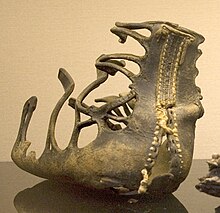Caligae
[2] In the early 1st century AD, the soldiery affectionately nicknamed the two- or three-year-old Gaius "caligula" ("little boot"), because he wore a diminutive soldier's outfit, complete with small caligae.
[3][4] Occasionally, hobnailed caligae must have proved inconvenient, especially on hard surfaces; Josephus describes the killing of a caliga-shod Roman centurion who had slipped on the Temple of Jerusalem's marble floor during an attack.
[1] Nevertheless, the design of the caliga allowed for its adjustment, which would have helped reduce chafing; it probably made an "ideal marching boot",[5] and "the thunderous sound of an attack by a hobnailed army (caligati) must have been terrifying".
In northern Britain's cold, wet climate, additional woven socks or raw wool wadding in winter may have helped insulate the feet, but caligae seemed to have been abandoned there by the end of the 2nd century AD, in favour of civilian-style "closed boots" (carbatinae).
The Spanish scholar Isidore of Seville believed that the name "caliga" derived from the Latin callus ("hard leather"), or else from the fact that the boot was laced or tied on (ligere).


